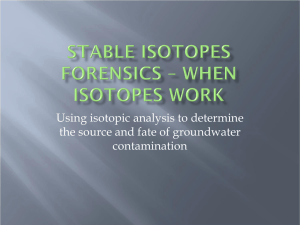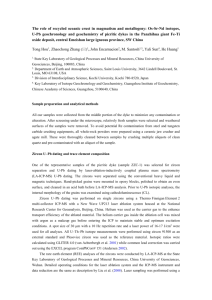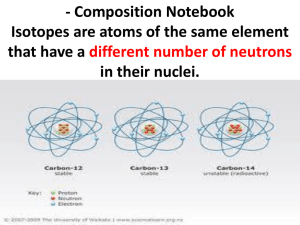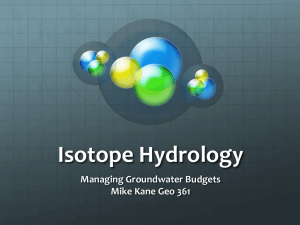Syllabus - Lefticariu Geochemistry Lab @ SIUC
advertisement
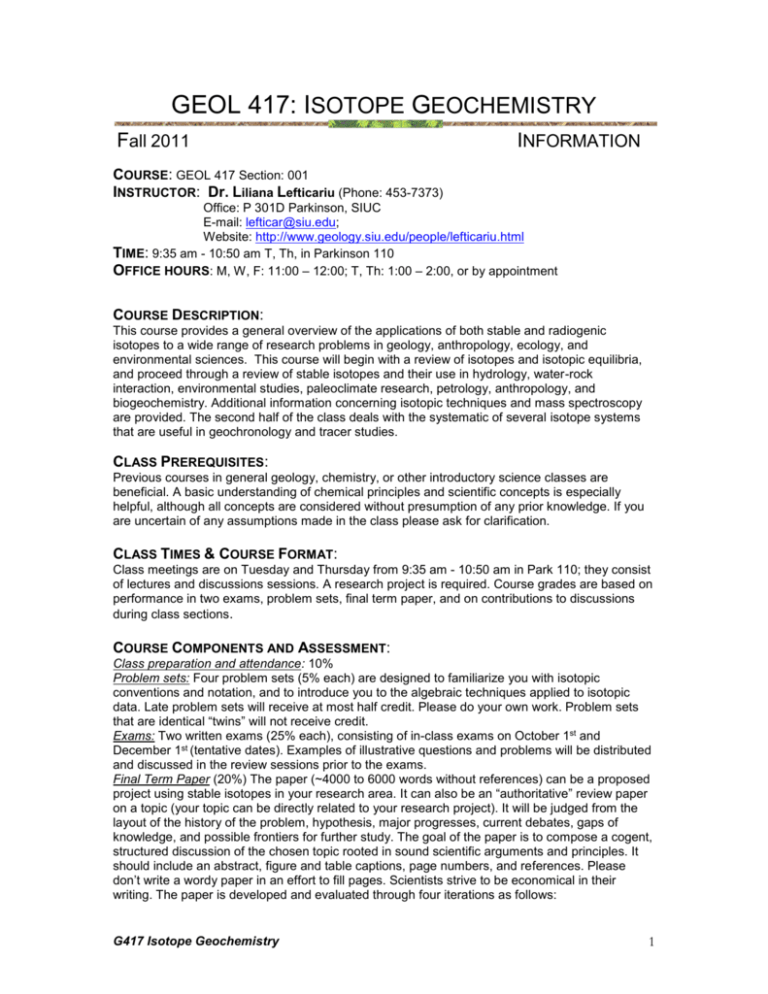
GEOL 417: ISOTOPE GEOCHEMISTRY Fall 2011 INFORMATION COURSE: GEOL 417 Section: 001 INSTRUCTOR: Dr. Liliana Lefticariu (Phone: 453-7373) Office: P 301D Parkinson, SIUC E-mail: lefticar@siu.edu; Website: http://www.geology.siu.edu/people/lefticariu.html TIME: 9:35 am - 10:50 am T, Th, in Parkinson 110 OFFICE HOURS: M, W, F: 11:00 – 12:00; T, Th: 1:00 – 2:00, or by appointment COURSE DESCRIPTION: This course provides a general overview of the applications of both stable and radiogenic isotopes to a wide range of research problems in geology, anthropology, ecology, and environmental sciences. This course will begin with a review of isotopes and isotopic equilibria, and proceed through a review of stable isotopes and their use in hydrology, water-rock interaction, environmental studies, paleoclimate research, petrology, anthropology, and biogeochemistry. Additional information concerning isotopic techniques and mass spectroscopy are provided. The second half of the class deals with the systematic of several isotope systems that are useful in geochronology and tracer studies. CLASS PREREQUISITES: Previous courses in general geology, chemistry, or other introductory science classes are beneficial. A basic understanding of chemical principles and scientific concepts is especially helpful, although all concepts are considered without presumption of any prior knowledge. If you are uncertain of any assumptions made in the class please ask for clarification. CLASS TIMES & COURSE FORMAT: Class meetings are on Tuesday and Thursday from 9:35 am - 10:50 am in Park 110; they consist of lectures and discussions sessions. A research project is required. Course grades are based on performance in two exams, problem sets, final term paper, and on contributions to discussions during class sections. COURSE COMPONENTS AND ASSESSMENT: Class preparation and attendance: 10% Problem sets: Four problem sets (5% each) are designed to familiarize you with isotopic conventions and notation, and to introduce you to the algebraic techniques applied to isotopic data. Late problem sets will receive at most half credit. Please do your own work. Problem sets that are identical “twins” will not receive credit. Exams: Two written exams (25% each), consisting of in-class exams on October 1st and December 1st (tentative dates). Examples of illustrative questions and problems will be distributed and discussed in the review sessions prior to the exams. Final Term Paper (20%) The paper (~4000 to 6000 words without references) can be a proposed project using stable isotopes in your research area. It can also be an “authoritative” review paper on a topic (your topic can be directly related to your research project). It will be judged from the layout of the history of the problem, hypothesis, major progresses, current debates, gaps of knowledge, and possible frontiers for further study. The goal of the paper is to compose a cogent, structured discussion of the chosen topic rooted in sound scientific arguments and principles. It should include an abstract, figure and table captions, page numbers, and references. Please don’t write a wordy paper in an effort to fill pages. Scientists strive to be economical in their writing. The paper is developed and evaluated through four iterations as follows: G417 Isotope Geochemistry 1 1. An initial extended outline/rough draft critiqued by instructors – due September 9. 2. A revised draft (electronic format) for anonymous peer review – due October 7. All students will be required to review two other papers – due November 11. 3. A complete final draft reviewed by instructors – due December 2. 4. Paper presentation and discussions: Fifteen-minute oral presentation will be given on Tuesday., December 13. Written report will be due Tuesday., December 13, at 5:00 PM. GRADE BREAKS: A = > = 87%; B = 75-86%; C = 65-74%; D = 55-65%; F = <55 % TEXT AND RESOURCES: Recommended Text: Principles of Stable Isotope Geochemistry, by Zachary Sharp, Princeton 2006, 344 p. This text provides a general introduction to many of the course themes in a narrative format. It offers a comprehensive treatment of several of the class topics and an adequate representation of most others. Most importantly it represents a companion to the class that supplements and augments the lecture materials. Its contents are not followed directly, and topics are considered in a different order from this text. Additional Resources: Stable Isotopes in Ecology and Environmental Sciences. 2007. Robert Michener and Kate Lajtha. Wiley-Blackwell; 2nd edition. Stable Isotope Forensics: An Introduction to the Forensic Application of Stable Isotope Analysis. 2010. Wolfram Meier-Augenstein, Wiley; 1st edition. Isotopes: Principles and Applications. 2005. Faure, G. and Mensing, T.M., Wiley, 464p. Principles of Stable Isotope Distribution. 1999. Criss R. E., Oxford University Press, 254p. Handbook of Stable Isotope Analytical Techniques. 2006. Pier de Groot, vol. I & II. See website http://users.pandora.be/handbook/index.html Environmental Tracers in Subsurface Hydrology. 2000. P.G. Cook and A.L. Herczeg, Eds. Kluwer Academic Press, Boston, 552p. ISBN 0-7923-7707-9. Stable Isotope Techniques in the Study of Biological Processes and Functioning of Ecosystems. 2001. M. Unkovitch, J. Plate, A. McNeill, and D.J. Gibbs, editors. Current Plant Science and Biotechnology in Agriculture, volume 40. Kluwer Academic Publishers, Dordrecht, Hardbound, ISBN 0-7923-7078-3, 304 pp. Environmental Isotopes in Hydrogeology. 1997. I. D. Clark and P. Fritz, CRC Press/Lewis Publishers, Boca Raton, 328 p., ISBN 1-56670-249-6. Problems of Stable Isotopes in Tree-Rings, Lake Sediments and Peat Bogs as Climatic Evidence for the Holocene. 1995. Frenzel B., Stauffer B., and Weiss M.M., Eds. Gustav Fischer Verlag, Stuttgart, 189pp. Stable isotope geochemistry. 2001 Valley J.W. & Cole D.R. Mineralogical Society of America. Reviews in Mineralogy, Vol. 43: 662 p. G417 Isotope Geochemistry 2 Stable isotopes in high temperature geological processes. 1986. Valley J.W., Taylor H.P. Jr. & O’Neil J.R. Mineralogical Society of America. Reviews in Mineralogy, Vol. 16: 570 p. [ISBN: 0-939950-20-0] Isotope Tracers in Catchment Hydrology. 1998. Kendall C. and McDonnell J.J., Eds. Elsevier, Amsterdam, 839 p. Especially valuable for N and S in hydrogeology. PRELIMINARY OUTLINE AND POTENTIAL TOPICS: A. Characteristics of isotopes (which isotopes and why) B. Stable isotope methods (why there is isotope geology) • Evolution of the mass spectrometer • Measurement of isotope ratios— isotope ratio mass spectrometer, ion microprobe • Sample preparation techniques • Conventions, notations, and standards D. Theoretical basis for isotopic fractionation (tedious but necessary) • Kinetic fractionation • Equilibrium fractionation E. Oxygen (18O/16O) and hydrogen (2H/1H) isotopes (it's the water) • Distribution in nature and fractionation relations • Oxygen and hydrogen isotopes in igneous and metamorphic rocks • Oxygen and hydrogen isotopes as tracers in natural waters • Sedimentary carbonates—paleotemperatures • Oxygen isotope stratigraphy of Quaternary, Tertiary, and Paleozoic marine sediments F. Carbon isotopes (13C/12C) (you are what you eat) • Carbon geochemistry • 13C/12C ratios in nature and fractionation relations • 13C in natural waters—carbon cycling in the ocean and terrestrial subsurface • 13C in organic matter—tracing the food web, origin of organic matter, changes in global pCO 2, tracing molecular markers, etc. • 13C in marine carbonates—the global carbon budget, ancient ocean chemistry, paleoceanography • Carbon and oxygen isotopes and carbonate diagenesis—temperature and chemistry of diagenetic fluids • Carbon and hydrogen isotopes in natural gas and petroleum—origin of methane G. Sulfur isotopes (34S/32S) (swamp gas and global change) • Sulfur geochemistry • 34S/32S ratios in nature and fractionation relations • Microbial processes and sulfur isotopes • Sulfur isotopes in groundwater sulfate—origin of sulfate, microbial processes • The sulfur isotope curve—major changes in ocean chemistry through time H. Geochronology and Isotope Tracer Studies EMERGENCY PROCEDURES: Southern Illinois University Carbondale is committed to providing a safe and healthy environment for study and work. Because some health and safety circumstances are beyond our control, we ask that you become familiar with the SIUC Emergency Response Plan and Building Emergency Response Team (BERT) program. Emergency response information is available on posters in G417 Isotope Geochemistry 3 buildings on campus, available on BERT's website at www.bert.siu.edu, Department of Safety's website www.dps.siu.edu (disaster drop down) and in Emergency Response Guideline pamphlet. Know how to respond to each type of emergency. Instructors will provide guidance and direction to students in the classroom in the event of an emergency affecting your location. It is important that you follow these instructions and stay with your instructor during an evacuation or sheltering emergency. The Building Emergency Response Team will provide assistance to your instructor in evacuating the building or sheltering within the facility. PRELIMINARY LECTURE SCHEDULE: Date Schedule of Topics 23-Aug-11 Introduction 25-Aug-11 Introduction 30-Aug-11 IRMS technique 1-Sept-11 IRMS technique 6-Sept-11 Principles of stable isotope fractionation 8-Sept-11 Principles of stable isotope fractionation 13-Sept-11 Hydrological cycle 15-Sept-11 Hydrological cycle 20-Sept-11 Hydrological cycle 22-Sept-11 Clay minerals 27-Sept-11 The oceans 29-Sept-11 4-Oct-11 Biogenic Carbonates Carbon Cycle 6- Oct -11 Isotopes in the Global Carbon Cycle 11- Oct -11 Fall vacation 13- Oct -11 Isotopes in the Global Carbon Cycle 18-Oct-11 Exam 1 20-Oct-11 Carbon Isotopes in fossil organic matter 25-Oct-11 N isotopes 27-Oct-11 S isotopes 1-Nov-11 S isotopes 3-Nov-11 Radioactive dating 8-Nov-11 Rb-Sr dating method 10-Nov-11 Sm-Nb dating method 15-Nov-11 Groundwater dating 17- Nov-11 Groundwater dating 22- Nov -11 U-Th dating method 24- Nov -11 Thanksgiving Break 29- Nov-11 U-Th dating method 1-Dec-11 K-Ar dating method G417 Isotope Geochemistry Reading Assignments Chapter 1 Problem Set 1 Homework 2 Problem Set 3a Homework 3b Homework 4a Homework 4b 4 6-Dec-11 Final Presentation 8-Dec-11 Final Presentation TBA Final Exam G417 Isotope Geochemistry 5



